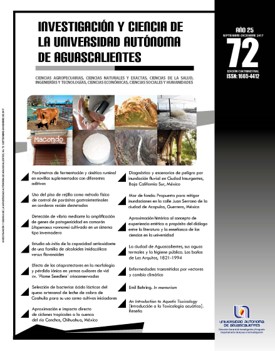Estudio ab initio de la capacidad antioxidante de una familia de alcaloides imidazólicos versus flavonoides
DOI:
https://doi.org/10.33064/iycuaa201772219Palabras clave:
antioxidantes, ab initio, alcaloides, flavonoides, Teoría de Funcionales de la Densidad, índices de reactividad globalesResumen
En este trabajo se estudiaron tres alcaloides imidazólicos; Lepidina D, E y F, y tres flavonoides; crisina, quercetina y camferol dentro del marco de la Teoría de Funcionales de la Densidad para determinar su capacidad antioxidante mediante el mecanismo de transferencia electrónica. Se aplicó la metodología B3LYP/6-31+G(d) para obtener las estructuras de mínima energía y los índices de reactividad globales. Para los alcaloides y flavonoides no hubo cambios sustanciales en los parámetros geométricos. En el caso de los índices de reactividad globales, el Potencial de Ionización muestra que en los alcaloides, la Lepidina F es el que tiene el valor más pequeño, sugiriéndolo como buen antioxidante con respecto a los flavonoides. Una conclusión importante de este trabajo es que los alcaloides podrían fungir como buenos antioxidantes debido a la fracción imidazol.
Descargas
Citas
Aksu, K., Topal, F., Gulcin, I., Tümer, F., & Göksu, F. (2015). Acetylcholinesterase inhibitory and antioxidant activities of novel symmetric sulfamides derived from phenethylamines. Archiv der Pharmazie: Chemistry in Life Sciences, 348(6), 446-455.
Becke, A. D. (1993). Density-functional thermochemistry. III. The role of exact exchange. The Journal of Chemical Physics, 98(7), 5648-5652. doi: 10.1063/1.464913
Ditchfield, R., Hehre, W. J., & Pople, J. A. (1971). Self‐consistent molecular‐orbital methods. IX. An extended gaussian‐type basis for molecular‐orbital studies of organic molecules. The Journal of Chemical Physics, 54(2), 724-728. doi: 10.1063/1.1674902
Fabijanić, I., Brala, C. J., & Pilepić, V. (2015). The DFT local reactivity descriptors of α-tocopherol. Journal of Molecular Modeling, 21(4), 99. doi: 10.1007/s00894-015-2644-y
García–Hernández, E., & Garza, J. (2017). Reactivity sites in dopamine depend on its intramolecular hydrogen bond. Journal of the Mexican Chemical Society, 61(3), 222-228.
Gülcin, I., Büyükokuroglu, M. E., & Küfrevioglu, O. I. (2003). Metal chelating and hydrogen peroxide scavenging effects of melatonin. Journal of Pineal Research, 34(4), 278-281.
Gülcin, I., Büyükokuroglu, M. E., Oktay, M., & Küfrevioglu, O. I. (2003). Antioxidant and analgesic activities of turpentine of Pinus nigra Arn. subsp. pallsiana (Lamb.) Holmboe. Journal of Ethnopharmacolology, 86(1), 51-58.
Halake, K., Birajdar, M., & Lee, J. (2016). Structural implications of polyphenolic antioxidants. Journal of Industrial and Engineering Chemistry, 35, 1-7. doi: 10.1016/j.jiec.2016.01.003
Havsteen, B. H. (2002). The biochemistry and medical significance of the flavonoids. Pharmacology & Therapeutics, 96(2-3), 67-202.
Maier, U. H., Gundlanch, H., & Zenk, M. H. (1998). Seven imidazole alkaloids from Lepidium sativum. Phytochemistry, 49(6), 1791-1795.
Middleton, E., Kandaswami, C., & Theoharides, T. C. (2000). The effects of plant flavonoids on mammalian cells: Implications for inflammation, heart disease, and cancer. Pharmacological Reviews, 52(4), 673-751.
Ortega–Moo, C., Garza, J., & Vargas, R. (2016). The substituent effect on the antioxidant capacity of cathecols and resorcinols. Theoretical Chemistry Accounts, 135, 177-188. doi: 10.1007/s00214-016-1932-7
Parr, R. G., & Yang, W. (1984). Density functional approach to the frontier-electron theory of chemical reactivity. Journal of the American Chemical Society, 106(14), 4049-4050. doi: 10.1021/ja00326a036
Qian, J. Z., Wang, B. C., Fan, Y., Tan, J., & Yang, X. (2015). QSAR study of flavonoid–metal complexes and their anticancer activities. Journal of Structural Chemistry, 56(2), 338-345. doi: 10.1134/S0022476615020195
Sepúlveda-Jiménez, G., Porta-Ducoing, H., & Rocha-Sosa, M. (2003). La participación de los metabolitos secundarios en la defensa de las plantas. Revista Mexicana de Fitopatología, 21(3), 355-363.
Shahidi, F., & Zhong, Y. (2010). Lipid oxidation and improving the oxidative stability. Chemical Society Reviews, 39(11), 4067-4079. doi: 10.1039/b922183m
Srivastava, A., Tandon, P., Ayala, A. P., & Jain, S. (2011). Solid state characterization of an antioxidant alkaloid boldine using vibrational spectroscopy and quantum chemical calculations. Vibrational Spectroscopy, 56(1), 82-88. doi: 10.1016/j.vibspec.2010.08.001
Valiev, M., Bylaska, E. J., Govind, N., Kowalski, K., Straatsma, T. P., Van Dam, H. J. J., …, de Jong, W. A. (2010). NWChem: a comprehensive and scalable open-source solution for large scale molecular simulations. Computer Physics Communications, 181(9), 1477-1489. doi: 10.1016/j.
cpc.2010.04.018
Villuendas–Rey, Y., Alvarez–Idaboy, J. R., & Galano, A. (2015). Assessing the protective activity of a recently discovered phenolic compound against oxidative stress using computational chemistry. Journal of Chemical Information and Modeling, 55(12), 2552-2561. doi: 10.1021/acs.jcim.5b00513
Zou, L., & Akoh, C. C. (2015). Antioxidant activities of annatto and palm tocotrienol-rich fractions in fish oil and structured lipid-based infant formula emulsion. Food Chemistry, 168, 504-511. doi: 10.1016/j.foodchem.2014.07.098
Descargas
Publicado
Cómo citar
Licencia
Las obras publicadas en versión electrónica de la revista están bajo la licencia Creative Commons Atribución-NoComercial-CompartirIgual 4.0 Internacional (CC BY-NC-SA 4.0)









